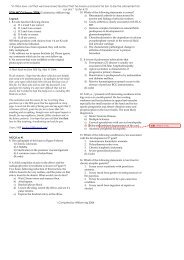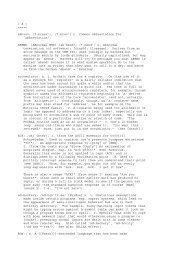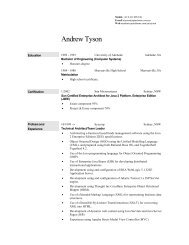Notes to Submission to the Productivity Commission Inquiry into the ...
Notes to Submission to the Productivity Commission Inquiry into the ...
Notes to Submission to the Productivity Commission Inquiry into the ...
You also want an ePaper? Increase the reach of your titles
YUMPU automatically turns print PDFs into web optimized ePapers that Google loves.
What sort of policies do governments undertake <strong>to</strong> offset some of <strong>the</strong> effects ofimpairment and disability? How can government intervention in support of people withimpairments be justified?Policy responses <strong>to</strong> impairment, activity restriction and disability can be classified in<strong>to</strong> atleast five types:• income protection (e.g. Disability Support Pension);• workplace wage subsidies and equipment grants <strong>to</strong> businesses that employ peoplewith impairments who would not o<strong>the</strong>rwise be employed;• provision of goods and services ei<strong>the</strong>r directly (e.g. Program of Appliances forDisabled People), indirectly (Attendant Care services), or by tied subsidies (e.g. TaxiTravel Scheme);• anti-discrimination regulations prohibiting <strong>the</strong> attribution of irrelevantcharacteristics <strong>to</strong> employees or potential employees (e.g. Disability Discrimination Actwith respect <strong>to</strong> employment) complemented by community education <strong>to</strong> promote <strong>the</strong>abilities and positive characteristics of people with impairments (e.g. Prime Minister’sAccess Award); and• regulations providing for a seamless spatial, political, commercial, intellectual andsocial environment and infrastructure <strong>to</strong> all individuals in <strong>the</strong> community (e.g. DisabilityDiscrimination Act with respect <strong>to</strong> buildings, transport, communication and education).Theoretically, <strong>the</strong>se government policies can be viewed as• enhancing efficiency in <strong>the</strong> sense of <strong>the</strong> Pare<strong>to</strong> criterion (i.e. <strong>the</strong> benefits of aprogram <strong>to</strong> <strong>the</strong> beneficiaries are greater than <strong>the</strong> costs <strong>to</strong> <strong>the</strong> beneficiaries, while no o<strong>the</strong>rparty (including taxpayers) bears any additional costs• fairness-enhancing in <strong>the</strong> sense that a more “worthy” person or group gains at <strong>the</strong>expense of a less “worthy” person or group• a combination of efficiency-enhancing and fairness-enhancing, where aggregatesocial benefits are greater than aggregate social costs and o<strong>the</strong>r parties (including nonbenefitingconsumers and/or taxpayers bear a cost).In practice, it is impossible <strong>to</strong> classify actual policies in<strong>to</strong> <strong>the</strong>ir efficiency/fairnessimpacts. Thus:• although income protection, workplace subsidies, and provision of goods andservices may be primarily fairness-enhancing, <strong>the</strong>y may also be efficiency-enhancing;• eliminating discrimination may primarily enhance efficiency but it is also likely <strong>to</strong>be redistributive; and• provision of a seamless public infrastructure will necessarily be both efficiencyenhancing and redistributive.There is a clear case for government involvement only when a program is bo<strong>the</strong>fficiency-enhancing and fairness-enhancing in its redistributive effect. Traditionaleconomics is predisposed <strong>to</strong> <strong>the</strong> view that <strong>the</strong>re is unlikely <strong>to</strong> be a need for efficiencyenhancingpolicies under general (Arrow-Debreu) conditions, since self-interested9
















